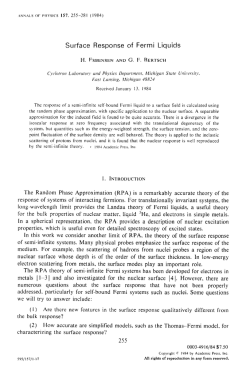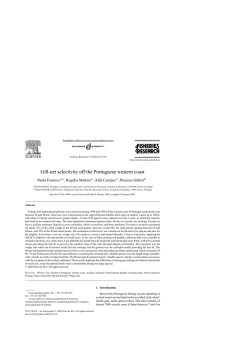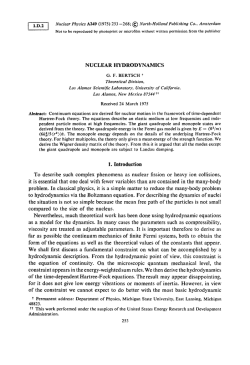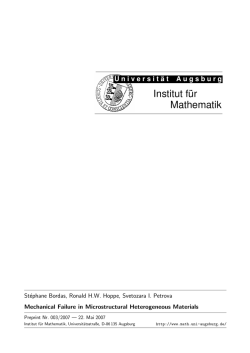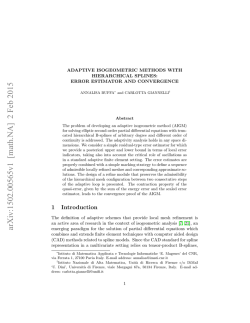
177. - Institute for Nuclear Theory
Computer Physics Communications 60 (1990) 247—255
North-Holland
247
An RPA program for jellium spheres
G. Bertsch
Department of Physics, Michigan State University, East Lansing~MI 48824, USA
Received 17 January 1990
A FORTRAN 77 program is presented that calculates the electromagnetic response of small metal particles or atomic
clusters. The program uses the random phase approximation and the local density approximation, and treats the clusters as
jeffium spheres. From the frequency-dependence response the polarizability, the plasmon resonance frequency, and the width
of the resonance lines are directly extracted.
PROGRAM SUMMARY
Title of program: JELLYRPA
Catalogue number: ABTC
Program obtainable from: CPC Program Library, Queen’s
University of Belfast, N. Ireland (see application form in this
issue), and by electronic mail from bertsch@msunscl
Computer: Digital VAX 780; Installation: National Superconducting Cyclotron Laboratory, Michigan State University
Operating system: VAX/VMS
Programming language used: FORTRAN 77
High speed storage required: 350 kwords
No. of bits in a word: 8
No. of lines in combined program and test deck: 485
Keywords: random phase approximation (RPA), local density
approximation (LDA), jellium spheres, polarization propagator, radial transition density, strength function, sum rules,
polarizability, plasmon, Mie resonance.
Nature of physical problem
The electromagnetic response of small metal particles and
atomic clusters is an object of current experimental interest,
The electric polarizability and the plasmon resonance are
0010-4655/90/$03.50 © 1990
—
measured, among other properties. The quantum-mechanical
theory of the response in the many-electron system is still not
fully developed, but the random phase approximation (RPA)
in the local density approximation (LDA) is simple and
accurate enough to serve as a theoretical baseline for more
elaborate treatments. The program JELLYRPA computes the
RPA/LDA response for small metal spheres, treating the
atomic cores as a uniform positively charged background.
Method of solution
JELLYRPA uses the polarization propagator method in coordinate space to solve the equations for the response of the
electrons to an external field. This method has the advantage
that unbound excitations can be treated quite realistically, with
the resonances automatically acquiring a width due to the
ionization of the electrons. The method allows excitations to be
calculated in very large spaces of configurations. The numerical difficulty in the evaluation of the polarization propagator is
controlled by the mesh size in coordinate space, since the
computation requires inversion of a matrix whose dimensionality is equal to the number of mesh points.
Restrictions on the complexity of the problem
The theory is best suited for closed-shell systems where a
Hartree—Fock or some effective mean-field theory provides a
good description of the ground state. Also, the polarization
propagator method relies on a simple representation of the
interaction, with very restricted possibilities for nonlocality. In
particular, the exchange interaction can only be calculated
approximately, in a zero-range approximation. The interaction
Elsevier Science Publishers B.V. (North-Holland)
248
G. Bertsch
/ An RPA program forjellium spheres
in the LDA is well suited to this method, because exchange
and correlation effects are approximated by a local function of
density.
Typical running time
250 s for input provided.
LONG WRITE-UP
1. Introduction
propagator, defined as
The electromagnetic response of small metal
particles and atomic clusters is an object of current experimental interest. The electric polarizability and the plasmon resonance are measured [1,2],
among other properties.
Plasma oscillations in a system of degenerate
electrons are often treated theoretically using the
random phase approximation (RPA), first discussed by Bohm and Pines [3]. The theory is
equivalent to the time-dependent Hartree—Fock
theory in the limit of small-amplitude oscillations.
The program JELLYRPA uses the polarization
propagator method in coordinate space, which is
very efficient if the electronic potential is a local
function of position. The exchange (or Fock)
potential does not satisfy this, but local approximations to exchange and correlation energies have
proven to be very successful, and one of these
parameterizations is adopted in JELLYRPA. The
JELLYRPA program is a modified version of the
RPA program used in the theory of nuclear excitations [4]. The first applications of this method to
electronic excitations in jellium spheres were by
Ekardt [5] and by Beck [6]. An alternative method
to compute the RPA response is by diagonalizing
a matrix in the space of electron configurations
[7].
11~( r,
Formally, the polarization propagator is a function of two spatial variables, r and r’, giving the
positions of a perturbing potential and the density
response to it. It is also a function of the frequency
to of the perturbation. The RPA approximation to
the polarization propagator is
~
r’, ta)
=
*
+
[T+
(r)
([ T +
V
—
—
w
v— ~+
(2)
where T is the kinetic energy operator, V is the
self-consistent potential, and e,. and 4~ are the
eigenenergies single-particle wave functions of the
Hamiltoman T + V. The residual interaction between electrons is defined by the functional derivative, 8V/8p, where p is the electron density.
JELLYRPA computes the RPA response for
spherical jellium clusters, with the potential given
by the sum of three terms: a background potential
from a uniform charge density (the “jellium”), the
Coulomb interaction between electrons, and the
exchange—correlation interaction from ref. [8].
JELLYRPA uses an angular-momentum representation of the functions appearing in the polarization propagator. This permits the RPA to be
calculated from independent radial equations for
each multipole, provided the static solution is
spherically symmetric. We define the multipolar
interaction VL as follows,
ÔV(r)
(r
=
~ ~
r
2)YL~(Pl)YLM(P2),
LM
where ~LM are the usual spherical harmonics. For
the Coulomb interaction, the VL is the usual Slater
form,
2
11RPA
Here
{i
110
+H0~}~0.
(1)
is the independent-particle polarization
(2L+1)e ~~TT~l~•
Coul
VL
=
The exchange—correlation interaction is of the
form of a density-dependent contact interaction
G. Bertsch
/ An RPA program forjellium spheres
with [8]
exc
VL
—
—
—
ing it in the array G(I, J). The matrix operations
____
~10.407
i~(r) +
is(1put
obtained
the
radial
to
evaluate
theoutput
factor
+ lThv/6p)’
eq.
areThe
thenuseful
performed
and
in thefrom
arrayin
B(I,
J).(1)
2
0.253
r~(r)
+ 11.4)\ ö(r—
p(r)rr’)
__________
________
Here ,~(r)is related to the local electron density
by r
1”3
and is expressed in
0(r)length
= (4lTp(r)/3)
atomic
units; the UL here has energy dimensions of rydbergs. The VL are stored in the
program in the two-dimensional array VRES(I, J).
The angular-momentum decomposition of the re-
transition densities associated with a given external field J’~~(r).These densities are defined as
8i~(r) = j0
8~~’A(r)
sponse
249
TI(r1, r2)
LM
~ ~L(n1,
=
is given by
~0
dr’1T~(r,r’, w)J’~~(r’),
f
d r ‘J1~PA(r, r’, to) J’~(r’).
0
—
—
2.
r2)Yj’~(Pl)YjM(P2)/(rlr2)
The single particle Green’s function is similarly
expanded in an angular-momentum basis labelled
by 1. Then the formula for the independent particle response is
These
quantities
are computed Ininthetheprogram
arrays
DRHOF(I)
and DRHORPA(I).
J~~(r)is defined as pure multipole field, 1’~~(r)
= r’~,stored in the array VEXT(I). The external
field is integrated over the transition density to
obtain the free and RPA response to the external
perturbation of the system
00
00
11~(J’~
5t~co)=Jdrf
1T~(r,r’, w)
21+1)(21’+l)(ZFO1OIL0)2
= ~
( 4’~(2L+ 1)
H~PA(V~
dr’J’~~(r)
to)=f00drf00dr’J’~t(r)
X11~(r, r’, w)J’~~(r’),
(4)
~
x u,(r)*u,(r~)([T+ V~
+[T+ v—
~—
1+ to]i~r’),
0
0
X11~’A(r,
~
(3)
where the sum over single-particle states, 1, /‘ is
restricted to those with orbital angular momentum
I and 1’ such that L + / + I’ is even. In this
equation, the u1 are the radial wave functions of
the occupied states, ~1(r) = u,(r)Y1(P)/r.
The radial Green’s function is evaluated in the
coordinate representation by the usual Green’s
function formula for second-order linear differential equations,
—1
u ( r<) w ( r>)
[T+ V ~1r,r’ =
W
Here u, w are solutions of the radial differential
equation that have appropriate boundary conditions, i.e. u must be regular at the origin and ~
must be a pure outgoing wave at infinity, and ~
is the Wronskian.
The program computes the independent partide response ~0 for each desired frequency, stor-
r’, to)I’~~(r’). (5)
The real and imaginary parts of these functions,
PIFREE and PIRPA, are the primary output
quantities printed by the program.
2. Physical quantities and sum rules
The units used in the program internally are
atomic units for length, 1 a.u. = 0.053 nm, and
rydbergs for energy, 1 Ry 2= =13.6
eV. In
units
2 and
thethese
electron’s
the
electronic
charge
is
e
mass is me = 1/2. However, for input and output
purposes energies and frequencies are expressed in
units of eV.
Physical applications often require the properties of individual quantum transitions. The quanturn mechanical response is defined in terms of
the transition strengths between an initial state i
and all final states f,
S(w)E<iIV~
2~(E~—E
5tIf)
I
1—to).
250
G. Bertsch
/ An RFA program forjellium spheres
The relation to the polarization propagator is simply
calculated from the above quantities by the equation
S(to)
~pR(r)
1
=
Im
(6)
IIL(Vext, to).
The response function is often used in applications. For example, inelastic scattering in the continuum is conveniently calculated using eq. (4)
with
being the transition field of the projectile, or some approximation to the projectile
interaction. The experimental strength function is
often smoother than the RPA prediction, either
because of experimental resolution or because of
physical damping processes not described by the
RPA. To facilitate comparison with smoothed
strengths, it is convenient to add an imaginary
~
part to the frequency. This is equivalent to convoluting the strength function with a Lorentzian.
Otherwise, only the boundary condition on the
single-particle Green’s function, that continuum
particles have outgoing asymptotic wave functions, provides an imaginary part to the response
and a width to the resonances.
In the neighborhood of a resonance of the
system, the response function may be expressed as
11(w)_~iIVIR)2(
1
I
=
I R>
f
00
dr’ 11~(r, r’)
xJ’~~(r’).
The integrated transition strengths obey sum
rules which are respected by the RPA theory. It is
an important check on calculations to see how
well the sum rules are satisfied numerically. Also,
it is convenient to express transition strengths as a
fraction of the appropriate sum rule, which
eliminates any possible ambiguity in the definition
of the strength functions.
The sum rules have the following form, valid
whenever the potential depends only on density,
f dr
fS(w)to dto =
)
~v
z.me
2
Po•
(7)
The program computes the sum rule for a given
angular momentum L from this formula, using
(~v)2
(F’(r))2
=
2
—
IF(r)) L(L+ 1).
T
With the pure multipole fields, the sum rule reduces to
JSL(w)w
dw= L(2L+1)j drr2’~p
0
8’Trm
where
ER and 172
are mode.
the realThis
imaginary
parts of
the
frequency
of the
connection
is
important for extracting the properties of individual resonances from the response. To find the
squared matrix element for an individual resonance, one first calculates the response over a
small frequency interval containing the mode in
question. One may then either fit the imaginary
part to the function Im( ER + iF/2 to) =
(T’/2)/((E~
+ (y/2)2) or simply integrate
over the interval,
—
— to)2
I
I R>2
JER+Lts(w) dto.
E~-~
The transition density associated with a resonance
is defined in terms of the matrix element of the
density operator as
= <i I
I R). It may be
21~2),
L(2L
8irm+ 1) N(r
where N is the number of electrons. When L = 1,
this is just the familiar f-sum rule, also known -as
the TRK sum rule,
—
—
fsito
dto =
3N
8Trme~
In the program, a loop allows the strength function to be computed over a range of energy, and
the total strength in that interval is compared with
the multipole sum rule.
The dipole sum rule may also be expressed in
terms of the photon absorption cross section. The
relationship is
Jo dto
=
2’r~2Ne2
m
5c
G. Bertsch
/ An RPA program forjellium spheres
This quantity is also printed when the L = 1 response is evaluated. The static polarizability of a
system, defined as the ratio of the induced dipole
moment and the electric field that induced it, is
given by
—
4
/
—
a
~HL=1kto
—0,.
This quantity is printed if the L = 1 response is
evaluated including the value at zero frequency.
The polarizability is very useful in making the
connection between the quantum and the classical
responses. For a classical conduction sphere, a =
R3. If one assumes that the polarizability is due to
the plasmon alone, the plasmon frequency can be
obtained from the ratio of f-sum rule to polarizability,
—
—
N2
macs
-_~._•
~‘
3. Program structure
The program is quite straightforward with the
computation of JJ(0) requiring the most attention.
The task of computing the self-consistent wave
functions and eigenenergies is done m the subroutine STATIC, using the same elementary integration method as GREEN. In GREEN each
function requires a single integration from one
extreme in radius to the other, with the direction
determined by the boundary condition. In
STATIC, the eigenenergy is determined by the
bisection method, looping over integrations of the
wavefunction. If consistency in the integration
methods between GREEN and STATIC is not
maintained, transition strength may appear at frequencies corresponding to transitions between occupied states. These Pauli-forbidden transitions in
principle cancel out in the two terms in eq. (2).
The subroutine RESPONSE computes the physical quantities at a fixed frequency, using the arrays
generated in STATIC and GREEN. The subroutine CLEBSCH which computes the Clebsch—
Gordan coefficients for eq. (3) is a general-purpose routine; there are more efficient formulas to
calculate the specific coefficients required by the
present application.
251
The most time-consuming part of the calculation is the inversion of the polarization matrix, the
first factor in eq. (1). Since the matrix is complex,
most available library inversion routines cannot be
used; a simple matrix-inversion subroutine,
MATR, is included with the program. If execution
time is a real consideration, matrix inversion
should not be used. Only the product of the inverse matrix with the vector DRHOF is needed to
obtain the vector DRHORPA. It is faster to obtam DRHORPA directly by solving the simultaneous equations.
The external field is determined in the subroutine EXTY. The spatial form of the field is a
pure multipole, ~ =
~L• The sum rule associated with the field, eq. (7), is calculated in the
subroutine SUMRULE. Other fields besides multipole fields may be of mterest. For example,
electron scattering could be represented by a
plane-wave field, which would have a Bessel function radial dependence in the multipole expansion.
If the user substitutes another field, the corresponding sum rule is automatically calculated by
SUMRULE.
r~’
4. Program input and test run
A detailed description of the format for the
input parameters is given in table 1. The first line
contains the parameters specifying the mesh in
coordinate space. Different mesh sizes can be used
for the wave-function integration and the matrix
inversion. The length scale of the mesh is set by
the radius of the jellium cluster, obtained from the
input on the second line. The integrations take
place over an interval equal to twice the radius of
the jellium cluster. Regarding the choice of a
suitable mesh interval, we note that a mesh spacing of 0.5 a.u. is quite adequate to obtain an
accuracy of less than 0.01 eV for the single-partide energies. Another consideration in the choice
of the mesh is to avoid a long integration into the
forbidden region; the algorithm is not stable here.
The mesh size for the matrix operations controls
the execution time of the program. The strength
functions can be computed to about 10% accuracy
with a mesh as coarse as 1 a.u.; for most calculations we use 0.5 a.u.
252
G. Bertsch
/ An RPA program forjellium spheres
On the second line are input parameters having
to do with the static mean-field calculation, as
r5,
positive
charge,
follows. The
density parameter
is given by
of the
RS.background
The total
charge of the background is Z, in units of the
elementary charge.
Thus
the radius
of the jeffium
1”3. The
number
of iterations
of
sphere is r5Z
a
Hartree
self-consistency
ioop
isiteration
given
by
the
produces
less
large
parameter
than
clusters
convergence
aITER.
percent.
are calculated,
TheUnfortunately,
on
test
all
the
output
has
quantities
ainvalue
if
extremely
process
that
to
will
a
numerical
not
converge,
parameter
and
the
inuser
acase
formula
will
have
to
STATIC
change
that updates the potential.
The next lines of input contain the quantum
numbers of the occupied single-particle states, one
line for each state. The table describes this in
Table 1
Input to the RPA program. The numerical values are the data
appropriate for the calculation of the dipole response of the
singly-charged cluster Na~
Line 1 NGRID, N, NX: NGRID =50 is the number of mesh
points in the spatial grid used to calculate the singleparticle wave functions. N =45 is the number of points
in the matrix representation of the polarization propagator. NX =1 is the spacing of these points in units of
the wave function mesh.
Line 2 RS, Z, ITER: RS = 3.93 (a.u.) is the radius of a sphere
of jellium containing a unit of charge. Z = 21 is the
total positive charge of the jellium,
1”3. ITER
so that= the
15 is
actual
the
radius of
number
of the
iterations
jelliumofistheRS
static
*Z
solution to approach
self-consistency,
Lines 3.1... 3.n LH, NODE, NOCC: These are the quantum
numbers for the occupied orbitals, with LH the orbital
angular momentum, NODE the number of internal
nodes in the radial wave function, and NOCC the
occupancy of the orbitaL IfNOCC = —1, the filled-shell
occupancy factor is used, NOCC =2 * (2 * LH + 1).Thus
the filled p-orbital in Na~ has LH = 1, NODE = 0,
NOCC = —1 or 6 electrons. The orbital data is
terminated by the line —1 0 0.
Line 4 L, EX, EXM, DEX, GAM: Here L = 1 is the multi polarity of the response. The response is calculated on
a grid of energies starting from EX = 0 eV and ranging
up to EXM=15 eVin steps of DEX=0.2 eV. GAM=
0.4 eV is an added imaginary part of the ener~’(actually i GAM/2 is added) to smooth the strength function,
~‘
3000
-
Free R..ponae
RPA Re.ponae
__
~
~
-
2000
~
z
0
~
1~~l
1 0000 0
-
2
4
6
ENERGY (eV)
Fig. 1. The dipole response functions, defined in eqs. (4 and 5),
are shown for the jellium cluster representing Na~
1.The solid
line and dashed lines show the independent particle response
and the RPA response, respectively.
more detail. Finally, the last line of input contains
the information about the multipolarity of the
response and the frequency. The frequency may
have a fixed imaginary part, given by half the
parameter GAM. Frequencies are calculated on a
mesh with the initial and final frequencies and the
frequency interval specified.
The test case shows the computation of the
dipole response for the singly-charged cluster
Na~1.The program first calculates the self-consistent particle states, and prints the eigenenergies
of each state. Then the response is calculated, with
the independent-particle and the RPA response
printed as complex numbers for each frequency.
Figure 1 shows a graph of the output. For the
independent particle response, the imaginary part
peaks at energies about 1 eV, corresponding to
single-particle transitions such as Od Of. Note
that the interacting response is much weaker for
low-energy transitions. This is the effect of the
screening. In the interacting response, there is a
dominant peak at 3.0—3.1 eV. This is the Mie
plasmon. It is red-shifted from the classical value,
to~=27.2(çY~”3
—3.4 eV, by about 13%.
An important check on the reliability of the
—~
computation is the sum rule. It may be seen from
the output that the f-sum rule is violated by 3%.
G. Bertsch
/ An RPA program forjellium spheres
253
Acknowledgement
[3] D. Pines and D. Bohm, Phys. Rev. 85 (1952) 338.
[4] S. Shlomo and G. Bertsch, NucI. Phys. A243 (1975) 507.
This work was supported by NSF grant no
PHY-8920927.
[5] W. Ekardt, Phys. Rev. B 31 (1985) 6360.
[61D.E. Beck, Phys. Rev. B 30 (1984) 6935; 35 (1987) 7325.
[71C. Yannouleas, R. Broglia, M. Brack, and P. Bortignon,
Phys. Rev. Lett. 63 (1989) 255.
[8] 0. Gunnarsson and B. Lundqvist, Phys. Rev. B 13 (1976)
References
[1] K. Selby et al., Phys. Rev. B 40 (1989) 5417.
[2] C. Brechignac, P. Cahuzac, F. Carlier and J. Leygnier,
Phys. Rev. Lett. 63 (1989) 1368.
4274.
254
G. Bertsch
/ An RPA program forjellium spheres
TEST RUN OUTPUT
50 grid points in win;
~l5in matrix; 1 relative step size
RS,Z,ITER= 3.93 21.0 15
R:
10.8112116
0
0
2.000000
1
0
6.000000
2
0
10.00000
0
1
2.000000
-1
0 0.0000000E+00
NET CHARGE =
1.000000
iteration number
15
L,NODE,E
0 0 -7.52008eV
L,NODE,E= 1 0 -6.78580eV
L,NODE,E= 2 0 —5.79885eV
L,NODE,E= 0 1 —5.1166’IeV
L=
1 GAM=
0.11000000
Energy
Free response
RPA Response
(eV)
Real
Imaginary
Real
Imaginary
Polarizability is
0.1506E+0ll a.u.**3
11 0.0000E+00 0. 1798E+03 0.0000E+00
0.00000
1071E+0
0.20000 0.
0.1096E+O’l
0.5918E+02 0.1806E+03 0.1605E+01
0.110000 0. 1 180E+011 0. 1392E+03 0. 1830E+03 0.33 18E+01
0.60000 0. 13411E+0ll 0.281’IE+03 0. 1871E+03 0.5279E+01
0.80000 0. 1628E÷0ll 0.6112E+03 0. 1933E+03 0.77311E+01
1.00000 0. 1890E+011 0. 1582E+0k 0.2020E+03 0.1 129E+02
1.20000 0.29146E+03 0.2987E÷011 0.2127E+03 0. 1771E+02
1 .~40000 -0.1 162E+011 0. 1600E+01I 0.2207E+03 0.2370E+02
1.60000 -0.8951E+03 0.6829E+03 0.2378E+03 0.25311E+02
1.80000 -0.5775E+03 0.11550E+03 0.2638E+03 0.3257E+02
2.00000 -0.5535E+03 0.114141E+03 0.2988E+03 0.46117E+02
2.20000 —0.5381E+03 0.2330E+03 0.311714E+03 0.6931E+02
2.110000 -0.’1238E+03 0. 1253E+03 0.14226E÷03 0.1 1110E+03
2.60000 —0.33711E+03 0.79614E+02 O.5399E+03 0.2202E+03
2.80000 -0.2757E+03 0.5581E+02 0.68311E÷03 0.5298E+03
3.00000 —0.2299E+03 0.lll6lIE+02 0.27116E÷03 0. 1217E+011
3.20000 —0. 19115E+03 0.3272E+02 —0.5361E+03 0.71160E+03
3.110000 -0.166 1E+03 0.2752E+02 -0.11390E+03 0.3082E÷03
3.60000 -0.1IIIIOE+03 0.26117E÷02 -0.3092E+03 0.1959E+03
3.80000 .-0.1298E+03 0.21112E+02 -0.2769E+03 0.11121E+03
11.00000 —0.1132E+03 0.2228E+02 -0.2268E+03 0.7609E+02
11.20000 -0.1050E+03 0.2709E+02 -0.1765E+03 0.5822E+02
14.110000 -0.1OIIIIE+03 0.21142E÷02-0.1503E+03 0.51472E+02
14.60000 -0.9502E+02 0. 13116E+02 -0. 13110E+03 0.3695E+02
~4.80o00-0.85110E+02 0.10011E+02 -0.1102E+03 0.35142E+02
5.00000 -0.7633E+02 0.9128E+01 -0.1 127E+03 0.3998E+02
5.20000 —O.702’IE÷02 0.8097E+01 -0.10117E+03 0.3111E+02
5 •14ooç~c~~0.61I9oE+o20.7136E+01 -0.96214E+02 0.2363E+02
5.60000 —0.60111E+02 0.61486E+01 -0.8755E+02 0. 1731E+02
5.80000 -0.5615E+02 0.6010E÷01.-0.7912E+02 0.1253E+02
6.00000 -0.52411E+02 0.5172E+01 -0.7181E+02 0.98911E+01
6.20000 -0.11902E+02 0.111171E+01 -0.65113E+02 0.7697E+01
6.110000 -0.’1589E+02 0.3881E+01 -0.5960E+02 0.6193E+01
6.60000 -0.11302E+02 0.33811E+01 -0.51168E+02 0.5130E+01
6.80000 —0.11039E+02 0.2968E+01 -0.5037E+02 0.11326E+01
7.00000 -0. 3799E+02 0.2621E+01 -0.’4659E+02 0. 3709E+01
7.20000 —0.3579E+02 0.2333E+01 ~0.1l325E+020.3227E+01
7.110000 -0.3377E+02 0.2092E+01 .~0.1I028E+02 0.281111E+01
7.60000 -0.3191E+02 0.1890E+01 ~0.37611E+020.2533E+01
G. Bertsch
7.80000 -0.3021E+02
/ An RPA program forjellium spheres
0.1718E+01 —0.3527E÷02 0.2276E+01
8.00000 _0.28611E+02 0.1571E+01 -0.3313E+02 0.2061E+01
8.20000 -0.2720E+02 0.111113E+01 -0.3120E+02 0.1878E+01
8.140000 —O.2586E+02 0.1331E+01 -0.291414E+02 0.1722E+01
14E+02 0. 1587E+01
8.60000 _0.21162E+02 0. 1232E+01 -0.278
8.80000 —0.23117E+02 0. 11145E+01 —0.2638E+02 0. 11170E+01
9.00000 —0.22111E+02 0. 1066E+o1 —0.2503E+02 0. 1366E+01
9.20000 —0.21’41E+02 0.99148E+00 —0.2380E+02 0. 1273E÷01
9.110000 -0.20148E÷02 0.93014E+00 —0.2266E+02 0. 1 189E+01
9.60000 —0.1961E+02 0.8717E+00 -0.2161E+02 0.1113E+01
9.80000 -0.1880E+02 0.8178E+00 -0.2063E+02 0.1O111E+01
10.00000 -0. l8OliE+02 0.7682E+00 -0. 1973E÷02 0.9739E+00
10.20000 -0. 1732E+02 0.7222E+OO -0. 1888E+o2 0.9107E+00
10.39999 ~0.1661IE+020.6795E+00 -0.1809E+02 0.8509E+00
10.59999 —0. 1601E+02 0.6398E+00 -0. 1735E+02 0.79144E+00
10.79999 ~0.151l1E+020.6028E÷00-o.1665E+02 0.71111E+00
10.99999 -0. 111811E+02 0.56811E+00 -0. 1600E+02 0.6911E+00
11.19999 -0.11131E+02 0.5366E÷O0-0. 1538E+02 0.641i5E÷00
11.39999 -0.1380E+02 0.5072E+00 -0.11180E+02 0.6013E+00
11.59999 —0. 1332E+02 0.i4801E+o0 -0. 11125E+02 0.5615E÷00
11.79999 -0. 1286E+02 0.115511E÷00 -0. 1373E+02 0.5253E+00
11.99999 -0. 12142E+02 0.11330E÷00 -0. 13214E+02 0.11926E÷00
12.19999 -0.1201E+02 0.11126E÷00 -0.1277E+02 0.11632E+00
12.39999 —0.1162E+02 0.39111E÷00 -0.1233E÷02 0.11370E÷00
12.59999 -0.1125E+02 0.3775E÷00-0.1191E+02 0.11138E+00
12.79999 —0.1089E+02 0.36211E+00 -0. 1151E+02 0.3932E+00
12.99999 —0. 1055E+02 0.3’185E+00 -0.11 13E÷02 0.37149E+00
13.19999 .—0.1023E+02 0.3357E+00 -0.1077E+02 0.3585E+00
13.39999 —0.9927E+01 0.3238E÷00-0.10113E÷02 0.31436E+00
13.59999 —0.9635E+01 0.3123E÷00-0. 1O11E÷02 0.3298E÷00
13.79999 -0.9356E+01 0.3013E÷QO-0.9800E+01 0.3169E+00
13.99999 -0.9090E+01 0.2905E+00 -0.9506E+01 0.30116E+00
111.19999 —0.8835E+01 0.2799E+00 -0.9227E+01 O.2927E÷00
114.39999 —0.8592E+01 0.2693E+00 —o.8960E+01 0.2811E+00
114.59999 -0.8358E+01 0.2587E+00 -0.8706E+01 0.2697E+00
14.79999 -0.81311E+01 0.21182E÷00 -0.81162E.s-01 0.25811E+00
111.99999 —0.7919E÷01 0.2377E÷00-0.8228E+01 0.2473E÷00
TOTAL STRENGTH IN FREE RESPONSE, RPA RESPONSE,
AND SUM RULE
0.8696E+03
0.8575E+03
0.8831E+03
energy-integrated photon cross section, (ev-A~2) 0.11260E+02
255
© Copyright 2026

